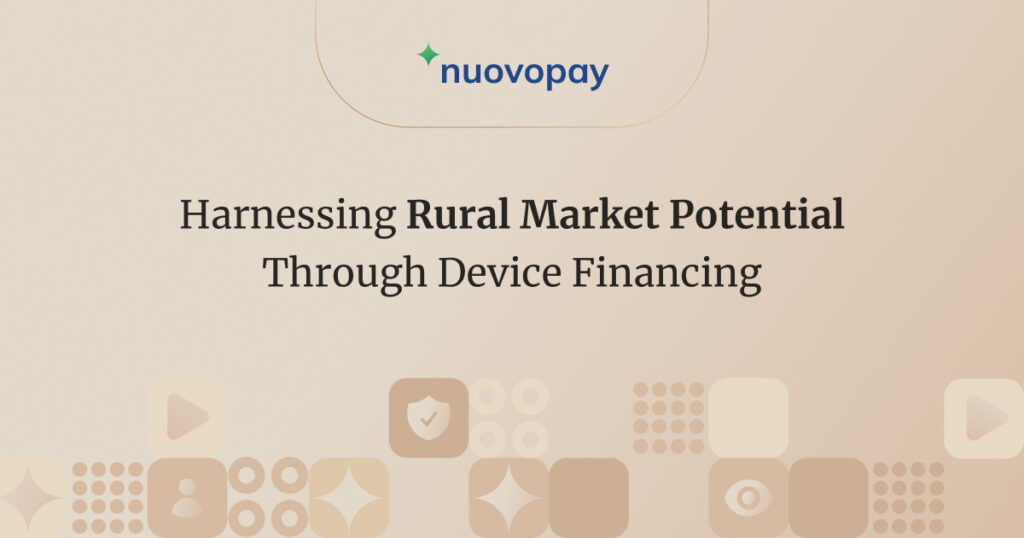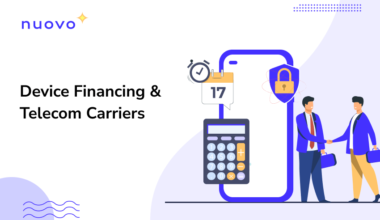Rural areas account for over 50% of the population in many developing countries, yet these markets remain significantly underserved. According to a report[1], only about 51.4% of rural households in sub-Saharan Africa have access to electricity, highlighting a stark gap in infrastructure and opportunities. This statistic underscores the immense potential and untapped opportunities within rural markets waiting to be unlocked.
One of the most promising strategies to bridge the digital infrastructure gap is device financing. By enabling rural consumers to afford modern technology through manageable payment plans, device financing can be a powerful tool to empower these communities. This approach enhances individual livelihoods and stimulates broader economic development.

This blog will deal with the current scenario of rural markets and the various challenges they face. We will explore the concept of device financing and why it is particularly suited to address the needs of rural populations.
Understanding Rural Markets
Economic and Social Characteristics
Rural markets are typically characterized by a strong dependence on agriculture and related activities. In many regions, the agricultural sector forms the backbone of the rural economy, providing livelihoods to a significant portion of the population. However, these areas often lack diversified economic activities, making them vulnerable to agricultural risks such as poor harvests, pests, and fluctuating commodity prices.
Socially, rural communities often have close-knit relationships and traditional lifestyles. However, they are also marked by lower levels of education, limited access to healthcare, and inadequate infrastructure compared to urban areas. These factors contribute to slower economic development and lower quality of life.
Growth Potential
Despite the socioeconomic challenges, rural markets hold immense growth potential. The global rural population is estimated to be around 3.4 billion, representing a vast and largely untapped consumer base. With appropriate interventions, these markets can be transformed into vibrant economic zones.
Key Industries and Sectors
- Agriculture: Adoption of modern farming techniques and access to better seeds, fertilizers, and machinery can significantly boost agricultural productivity. Agritech innovations, such as mobile apps for market prices and weather updates, can empower farmers with real-time information.
- Healthcare: Telemedicine and mobile health clinics can address healthcare access issues, improving health outcomes and productivity. Investments in healthcare infrastructure and services can also create jobs and stimulate economic activity.
- Education: E-learning platforms and educational technology can bridge the educational gap, enhancing skills and employability. Improving access to education can have a multiplier effect on economic development, as a more educated workforce can drive innovation and growth.
- Retail and Consumer Goods: Rising incomes in rural areas can spur demand for consumer goods, creating new markets for businesses. Microfinance and credit facilities can enable rural consumers to purchase goods and services, driving economic activity.
Role of Device Financing
Device financing is a financial strategy that allows consumers to acquire devices, such as smartphones, tablets, and other gadgets, through flexible payment plans rather than paying the full cost upfront. This approach makes it easier for individuals, especially those with limited financial resources, to access and own technology.
How Device Financing Increases Accessibility and Affordability
- Lower Upfront Costs: Device financing reduces the financial burden on consumers by spreading the cost of the device over several months or years, making high-cost technology affordable.
- Increased Adoption of Technology: Affordable access to devices enables more people in rural areas to adopt and use technology, bridging the digital divide. This increased adoption can lead to enhanced connectivity, access to information, and improved quality of life.
- Empowerment Through Ownership: Owning a device rather than borrowing or renting increases personal investment, leading to better maintenance and usage. Ownership can also foster a sense of empowerment and self-sufficiency.
Benefits of Device Financing in Rural Markets
Economic Empowerment: Access to Devices and Economic Opportunities
- Small Businesses: Devices such as smartphones and tablets enable rural entrepreneurs to access markets, communicate with customers, and manage their businesses more efficiently. Mobile banking apps facilitate financial transactions, enabling small businesses to receive payments, access credit, and manage their finances securely.
- E-commerce: Rural artisans and producers can leverage online platforms to market their products to a wider audience. E-commerce platforms enable rural consumers to access a broader range of goods and services, creating opportunities for local businesses to expand their customer base beyond geographical constraints.
- Digital Skills Development: Access to devices opens up opportunities for rural residents to learn new skills, such as digital marketing, coding, and online sales. These skills empower individuals to explore alternative sources of income and participate in the digital economy, reducing dependence on traditional livelihoods.
Education and Skill Development: Impact of Device Access on Education
- E-Learning: Devices facilitate access to online educational resources, including video lectures, e-books, and interactive learning platforms. Distance learning programs enable rural students to access quality education without the need to travel long distances to urban centers.
- Skill Development: Educational apps and platforms offer opportunities for skill development in areas such as language learning, computer literacy, and vocational training. Access to educational content broadens horizons and equips individuals with the skills needed to pursue higher education or secure employment opportunities.
Healthcare Improvements: Technology-Enabled Healthcare Services
- Telemedicine: Devices facilitate remote consultations with healthcare professionals, allowing rural residents to access medical advice and treatment without the need to travel long distances. Telemedicine services reduce healthcare costs and improve health outcomes by enabling early diagnosis and intervention.
- Health Apps: Mobile health apps provide access to valuable healthcare information, medication reminders, and tools for monitoring health parameters. These apps empower individuals to take control of their health and well-being, leading to preventive healthcare practices and better management of chronic conditions.
Challenges Faced By Rural Section: Barriers to Implementation
Many rural residents lack basic financial literacy skills, making it difficult for them to understand the terms and implications of device financing agreements. Misunderstandings about interest rates, repayment terms, and consequences of defaulting can lead to reluctance or mismanagement of device financing.
Rural residents may have limited access to formal banking services, including savings accounts, which are often prerequisites for device financing. The absence of banking infrastructure restricts the availability of financial services and inhibits participation in formal credit markets.
Rural consumers may have concerns about the security of their personal and financial information when engaging in digital transactions. Lack of trust in the security of digital transactions can deter rural residents from participating in device financing programs, limiting their access to technology.
Closing Lines
As a leading Device Financing Risk Management (DFRM) platform, NuovoPay can unlock some true potential of rural markets. By addressing the mentioned challenges through strategic partnerships, targeted interventions, and technological innovations, NuovoPay can overcome barriers to implementing device financing in rural areas. This will empower rural communities with access to technology.
Reference:





